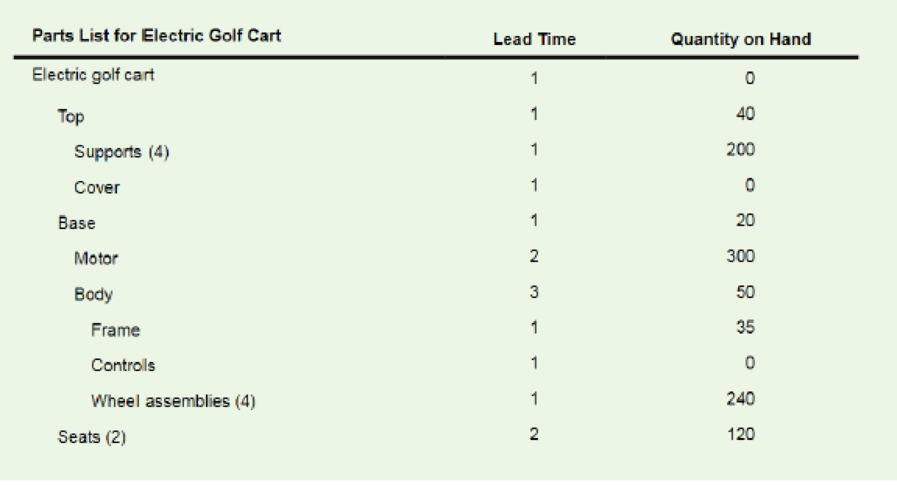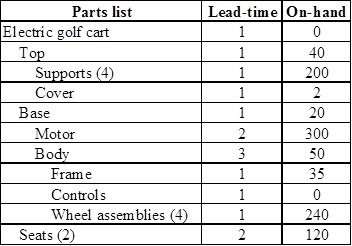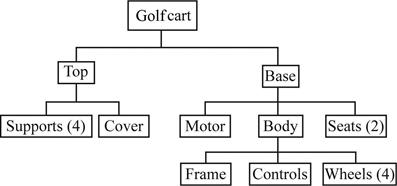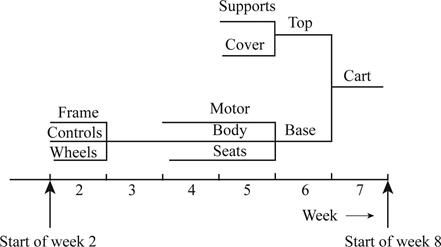
Concept explainers
A firm that produces electric golf carts has just received an order for 200 carts, which must be ready for delivery at the start of week 8. Information concerning the product structure, lead times, and quantities on hand is shown in the following table. Use this information to do each of the following:
a. Construct a product tree.
b. Construct an assembly time chart.
c. Develop a material requirements plan that will provide 200 golf carts by week 8 assuming lot-for-lot ordering.

a)
To construct: A product tree
Introduction: Materials Requirement Planning (MRP) is the planning or scheduling system, which can be used in the manufacturing process. It is used to plan the number of items required to produce one unit of finished goods (end item).
Explanation of Solution
Given information:

Construct a product tree:

b)
To construct: An assembly time chart
Introduction: Materials Requirement Planning (MRP) is the planning or scheduling system, which can be used in the manufacturing process. It is used to plan the number of items required to produce one unit of finished goods (end item).
Explanation of Solution
Given information:

Construct an assembly time chart:

c)
To prepare: Materials Requirement planning using the provided information.
Introduction: Materials Requirement Planning (MRP) is the planning or scheduling system, which can be used in the manufacturing process. It is used to plan the number of items required to produce one unit of finished goods (end item).
Explanation of Solution
Given information:
The company needs to provide 200 golf carts by week 8.

Develop a material requirement planning for golf cart:

- It is given that the company needs to provide 200 golf carts by week 8.
- Beginning inventory is 0 units.
- Net requirement can be calculated by subtracting the projected on-hand from the gross requirement. Hence, the net requirement is 200 units in week 8 (200-0).
- Planned order release is the order given by the company and planned order receipts is the order received by the firm.
- Lead-time is given as 1 week. Company requires 200 units in the beginning of Week 8. Hence, they need to order for 200 units (as the lot size is lot-for-lot) on previous week (as the lead-time is 1 week). Thus, company need to order the required units in week 7.
Develop a material requirement planning for top:

- Golf cart is the parent for top. Hence, the planned order release of the golf cart would be the gross requirement of the top. As number of units required is 1 for top, the planned order release row of golf cart should be multiplied with 1 to attain the gross requirement column of top.
- Beginning inventory is 40 units.
- Net requirement can be calculated by subtracting the projected on-hand from the gross requirement. Hence, the net requirement is 160 units in week 7 (200-40).
- Planned order release is the order given by the company and planned order receipts is the order received by the firm.
- Lead-time is given as 1 week. Company requires 160 units in the beginning of Week 7. Hence, they need to order for 160 units (as the lot size is lot-for-lot) on previous week (as the lead-time is 1 week). Thus, company need to order the required units in week 6.
- Projected on hand inventory for week 8 is 0 units. Calculation is as follows:
Develop a material requirement planning for supports (4):

- Top is the parent for supports. Hence, the planned order release of the top would be the gross requirement of the supports. As number of units required is 4 for supports, the planned order release row of top should be multiplied with 4 to attain the gross requirement column of support.
- Beginning inventory is 200 units.
- Net requirement can be calculated by subtracting the projected on-hand from the gross requirement. Hence, the net requirement is 440 units in week 6 (640-200).
- Planned order release is the order given by the company and planned order receipts is the order received by the firm.
- Lead-time is given as 1 week. Company requires 440 units in the beginning of Week 6. Hence, they need to order for 440 units (as the lot size is lot-for-lot) on previous week (as the lead-time is 1 week). Thus, company need to order the required units in week 5.
- Projected on hand inventory for week 7 is 0 units. Calculation is as follows:
Develop a material requirement planning for cover:

- Top is the parent for cover. Hence, the planned order release of the top would be the gross requirement of the cover. As number of units required is 1 for cover, the planned order release row of top should be multiplied with 1 to attain the gross requirement column of cover.
- Beginning inventory is 0 units.
- Net requirement can be calculated by subtracting the projected on-hand from the gross requirement. Hence, the net requirement is 160 units in week 6 (160-0).
- Planned order release is the order given by the company and planned order receipts is the order received by the firm.
- Lead-time is given as 1 week. Company requires 160 units in the beginning of Week 6. Hence, they need to order for 160 units (as the lot size is lot-for-lot) on previous week (as the lead-time is 1 week). Thus, company need to order the required units in week 5.
Develop a material requirement planning for base:

- Golf cart is the parent for base. Hence, the planned order release of the golf cart would be the gross requirement of the base. As number of units required is 1 for base, the planned order release row of golf cart should be multiplied with 1 to attain the gross requirement column of base.
- Beginning inventory is 20 units.
- Net requirement can be calculated by subtracting the projected on-hand from the gross requirement. Hence, the net requirement is 180 units in week 7 (200-20).
- Planned order release is the order given by the company and planned order receipts is the order received by the firm.
- Lead-time is given as 1 week. Company requires 180 units in the beginning of Week 7. Hence, they need to order for 180 units (as the lot size is lot-for-lot) on previous week (as the lead-time is 1 week). Thus, company need to order the required units in week 6.
- Projected on hand inventory for week 8 is 0 units. Calculation is as follows:
Develop a material requirement planning for motor:

- Base is the parent for motor. Hence, the planned order release of the base would be the gross requirement of the motor. As number of units required is 1 for motor, the planned order release row of base should be multiplied with 1 to attain the gross requirement column of motor.
- Beginning inventory is 300 units.
- Gross requirement for week 6 is 180 units. As the beginning inventory is sufficient to satisfy the demand, there is no necessary to place an order.
- Projected on hand inventory for week 7 is 120 units. Calculation is as follows:
Develop a material requirement planning for body:

- Base is the parent for body. Hence, the planned order release of the base would be the gross requirement of the body. As number of units required is 1 for body, the planned order release row of base should be multiplied with 1 to attain the gross requirement column of body.
- Beginning inventory is 50 units.
- Net requirement can be calculated by subtracting the projected on-hand from the gross requirement. Hence, the net requirement is 130 units in week 6 (180-50).
- Planned order release is the order given by the company and planned order receipts is the order received by the firm.
- Lead-time is given as 3 weeks. Company requires 130 units in the beginning of Week 6. Hence, they need to order for 130 units (as the lot size is lot-for-lot) before three weeks (as the lead-time is 3 weeks). Thus, company need to order the required units in week 3.
- Projected on hand inventory for week 7 is 0 units. Calculation is as follows:
Develop a material requirement planning for seats (2):

- Base is the parent for seats. Hence, the planned order release of the base would be the gross requirement of the seats. As number of units required is 1 for seats, the planned order release row of base should be multiplied with 1 to attain the gross requirement column of seats.
- Beginning inventory is 120 units.
- Net requirement can be calculated by subtracting the projected on-hand from the gross requirement. Hence, the net requirement is 240 units in week 6 (360-120).
- Planned order release is the order given by the company and planned order receipts is the order received by the firm.
- Lead-time is given as 2 weeks. Company requires 240 units in the beginning of Week 6. Hence, they need to order for 240 units (as the lot size is lot-for-lot) before two weeks (as the lead-time is 2 weeks). Thus, company need to order the required units in week 4.
- Projected on hand inventory for week 7 is 0 units. Calculation is as follows:
Develop a material requirement planning for frame:

- Body is the parent for frame. Hence, the planned order release of the body would be the gross requirement of the frame. As number of units required is 1 for frame, the planned order release row of body should be multiplied with 1 to attain the gross requirement column of frame.
- Beginning inventory is 35 units.
- Net requirement can be calculated by subtracting the projected on-hand from the gross requirement. Hence, the net requirement is 95 units in week 3 (130-35).
- Planned order release is the order given by the company and planned order receipts is the order received by the firm.
- Lead-time is given as 1 week. Company requires 95 units in the beginning of Week 3. Hence, they need to order for 95 units (as the lot size is lot-for-lot) on previous week (as the lead-time is 1 week). Thus, company need to order the required units in week 2.
- Projected on hand inventory for week 4 is 0 units. Calculation is as follows:
Develop a material requirement planning for controls:

- Body is the parent for controls. Hence, the planned order release of the body would be the gross requirement of the controls. As number of units required is 1 for controls, the planned order release row of body should be multiplied with 1 to attain the gross requirement column of controls.
- Beginning inventory is 0 units.
- Net requirement can be calculated by subtracting the projected on-hand from the gross requirement. Hence, the net requirement is 130 units in week 3 (130-0).
- Planned order release is the order given by the company and planned order receipts is the order received by the firm.
- Lead-time is given as 1 week. Company requires 130 units in the beginning of Week 3. Hence, they need to order for 130 units (as the lot size is lot-for-lot) on previous week (as the lead-time is 1 week). Thus, company need to order the required units in week 2.
Develop a material requirement planning for wheel assemblies (4):

- Body is the parent for wheel assemblies. Hence, the planned order release of the body would be the gross requirement of the wheel assemblies. As number of units required is 4 for wheel assemblies, the planned order release row of body should be multiplied with 4 to attain the gross requirement column of wheel assemblies.
- Beginning inventory is 240 units.
- Net requirement can be calculated by subtracting the projected on-hand from the gross requirement. Hence, the net requirement is 280 units in week 3 (520-240).
- Planned order release is the order given by the company and planned order receipts is the order received by the firm.
- Lead-time is given as 1 week. Company requires 280 units in the beginning of Week 3. Hence, they need to order for 280 units (as the lot size is lot-for-lot) on previous week (as the lead-time is 1 week). Thus, company need to order the required units in week 2.
- Projected on hand inventory for week 4 is 0 units. Calculation is as follows:
Want to see more full solutions like this?
Chapter 12 Solutions
Loose-leaf for Operations Management (The Mcgraw-hill Series in Operations and Decision Sciences)
Additional Business Textbook Solutions
Financial Accounting: Tools for Business Decision Making, 8th Edition
Horngren's Accounting (12th Edition)
Principles of Microeconomics (MindTap Course List)
Essentials of MIS (13th Edition)
Horngren's Cost Accounting: A Managerial Emphasis (16th Edition)
Intermediate Accounting (2nd Edition)
- what is an other difination for principle?arrow_forwardNeed help or ideas to design out two slides as my script and writing quite long to squeese into two slides. But can just point form in slides with correct title and a good script for me to present two slides in only 2.5 mins. Following is my draft, pls guide me step by step on powerpoint creation and good script to present findings. My draft: Slide 1: Foreign Labor Exploitation in Dyson's Supply Chain Introduction Dyson's former Malaysian supplier, ATA IMS Bhd, became embroiled in serious labor exploitation allegations in 2021. These concerns surfaced when whistleblowers exposed unethical labor practices affecting migrant workers, primarily from Nepal and Bangladesh. Key Forms of Exploitation Debt Bondage Due to Recruitment Fees Workers were forced to pay exorbitant recruitment fees before securing employment, often taking loans at high interest rates. This financial burden trapped them in debt bondage, leaving them with little choice but to accept exploitative working…arrow_forwardNot use ai pleasearrow_forward
- The Business Development Bank of Canada. (2023). Canadian economic outlook for 2024: Shifting into neutral. https://www.bdc.ca/en/articles-tools/blog/canadian-economic-outlook-for-2024-shifting-into-neutral “Despite persistently high inflation and rising interest rates, the news was generally better than expected for the Canadian economy in 2023” (BDC Blog 2024). Discussion Question: In your view, what are the most pressing problems for Canadian companies or consumers in 2024? Explain your answer using current examples of companies or consumer concerns.arrow_forwardhow have idividual objectives led to the current situation at TeraCog? what should Emaa do?arrow_forwardCan you write me an email about addressing an issue to mentor my supervisor the right way of deligating operations dutiesarrow_forward
- Can you right me an email about addressing an issue to mentor the right why of deligating operations dutiesarrow_forwardDefine delegation. Discuss in detail the four reasons why managers do delegation? Also statethe four main types of delegation.arrow_forwardB) Going forward, is Lean/JIT worth the risks? Should it be embraced (why?), abandoned (if so, why & what are the costs), or modified (how?) Do you think Lean works or not? Please write a complete response (about 1-2 paragraphs each part). Each team member should discuss and contribute so that the group agrees on their joint response. Please help each other and build upon and/or challenge others' points (in a respectful way!)arrow_forward
- Discuss the principle reasons that employee benefits have risen over the past 20 years, along with how best an organization can provide employees with a fair wage yet also provide some level of employee benefit coverage.arrow_forwardPlease assist with the Case Study below as attached. Read the case study below and answer the questions that follow. The Importance of the Planning Phase to Project Success. Traditional wisdom is that planning and analysis are very important and the more there is in a project, the more successful the project will be. Time spent on these activities will reduce risk and increase project success. On the other hand, inadequate analysis and planning will lead to a failed project. If poor planning has led to failed projects, then perhaps billions of dollars have been lost. But how much is too much? “Light weight” project management techniques such as agile are gaining popularity. Part of their ethos is that less initial planning is better and an evolutionary process is more efficient. QUESTION 1 The article above states: “Traditional wisdom is that planning and analysis are very important and the more there is in a project, the more successful the project will be”. Describe FIVE (5) ways…arrow_forwardOn a daily basis, the van is dispatched from Maplewood Hospital to pickup blood and platelet donations made at its local donation centers. The distances in miles between all locations may be found in the table below. Click the icon to view mileage data for Vampire Van. a. The van travels from the Hospital (A) to (B) to (C) to (D) to (E) and then returns to the Hospital (A). What is the total number of miles that the van must travel using this route? Route ABCDEA requires a total distance of 20.4 miles. (Enter your response rounded to one decimal place.) b. Using Maplewood Hospital as the beginning location, create a route using the Nearest Neighbor heuristic. What is the total number of miles that the van must travel using this route? The new route is A A and requires a total distance of miles. (Enter your response rounded to one decimal place.) More Info Maplewood City Center Westbrook Hospital (A) Donation Site (B) Donation Site (C) Municipal Park Donation Site (D) Valley Hills…arrow_forward
 Practical Management ScienceOperations ManagementISBN:9781337406659Author:WINSTON, Wayne L.Publisher:Cengage,MarketingMarketingISBN:9780357033791Author:Pride, William MPublisher:South Western Educational Publishing
Practical Management ScienceOperations ManagementISBN:9781337406659Author:WINSTON, Wayne L.Publisher:Cengage,MarketingMarketingISBN:9780357033791Author:Pride, William MPublisher:South Western Educational Publishing Purchasing and Supply Chain ManagementOperations ManagementISBN:9781285869681Author:Robert M. Monczka, Robert B. Handfield, Larry C. Giunipero, James L. PattersonPublisher:Cengage Learning
Purchasing and Supply Chain ManagementOperations ManagementISBN:9781285869681Author:Robert M. Monczka, Robert B. Handfield, Larry C. Giunipero, James L. PattersonPublisher:Cengage Learning Contemporary MarketingMarketingISBN:9780357033777Author:Louis E. Boone, David L. KurtzPublisher:Cengage Learning
Contemporary MarketingMarketingISBN:9780357033777Author:Louis E. Boone, David L. KurtzPublisher:Cengage Learning





